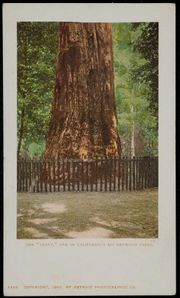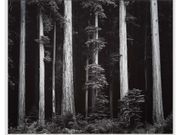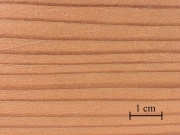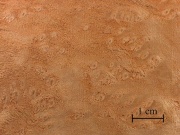Difference between revisions of "Redwood"
JMcGlinchey (talk | contribs) |
|||
| (5 intermediate revisions by 3 users not shown) | |||
| Line 1: | Line 1: | ||
| − | [[File: | + | [[File:Redwood Giant MFA.jpg|thumb|Redwood Giant<br>MFA# 2013.6265]] |
| − | + | [[File:Redwoods Bull Creek MFA.jpg|thumb|Redwoods by Ansel Adams<br>MFA# 1975.721]] | |
| − | |||
== Description == | == Description == | ||
| − | A soft, red coastal tree, ''Sequoia sempervirens'', found within 30 miles of the Pacific coast in northern California and southern Oregon. Redwoods are the tallest living trees and | + | A soft, red coastal tree, ''Sequoia sempervirens'', found within 30 miles of the Pacific coast in northern California and southern Oregon. Redwoods are the tallest living trees and some are more than 2000 years old. The redwood tree produces of lightweight, spongy wood that has a straight grain. The strong, durable wood is used for bridges, boxes, lumber, shingles, siding, fencing, and decking. Natural tannin dyes in the wood tend to cause brown stains in paint films. Redwood is resistant to decay and insect attack. It significantly expands and contracts with changes in humidity. Peak lumbering years were 1910-1930. |
| − | [[File:20_Redwood.jpg|thumb|Redwood | + | [[File:20_Redwood.jpg|thumb|Redwood (''Sequoia sempervirens'')]] |
| − | + | [[File:Redwood.jpg|thumb|Redwood burl (''Sequoia sempervirans'')]] | |
| − | (''Sequoia | ||
== Synonyms and Related Terms == | == Synonyms and Related Terms == | ||
| − | Sequoia sempervirens; sequoia pine; California redwood; humbolt redwood; rødtræ (Dan.); Küstenmammutbaum (Deut.); secuoya (Esp.); séquoia à feuilles d'if (Fr.); séquoia toujours vert (Fr.); sequoia (It.); kustmammoetboom (Ned.); sequóia (Port.); Amerikansk sekvoja (Sven.) | + | ''Sequoia sempervirens''; sequoia pine; California redwood; coast redwood; humbolt redwood; rødtræ (Dan.); Küstenmammutbaum (Deut.); secuoya (Esp.); séquoia à feuilles d'if (Fr.); séquoia toujours vert (Fr.); sequoia (It.); kustmammoetboom (Ned.); sequóia (Port.); Amerikansk sekvoja (Sven.) |
| − | == | + | == Physical and Chemical Properties == |
| − | + | * Height reaching to 112 m with truck diameter of 7m. | |
| − | + | * Bark = thick, deeply furrowed, and resistant to fire and fungus. | |
| − | Specific gravity = 0.37-0.38. | + | * Leaves= needles (15-25 mm). |
| − | + | * Cones=ovoid (15-32 mm long) with spirally arranged scales. | |
| − | + | * Specific gravity = 0.37-0.38. | |
| − | + | * Density = 28-50 ppcf | |
| − | + | * Heartwood ranges from a light pinkish brown to a deep reddish brown. Sapwood is a pale white/yellow. | |
| − | + | * Sometimes curly figure or Redwood burl (sometimes referred to as “lace” or by the name Vavona) are seen | |
| − | + | * Grain is generally straight with a coarse texture and low natural luster | |
Paper fiber type: softwood. Using transmitted light microscopy, fibers are identified by the presence of large, uniform-sized taxodiod pits 3+ across. Fibers are wide. Appearance with [[Graff "C" stain]]: varies with pulping and bleaching. Average dimensions of fibers: length 7.0mm, width 60-65μm. Common pulping method: [[kraft process|kraft]] and [[sulfite process|sulfite]]. | Paper fiber type: softwood. Using transmitted light microscopy, fibers are identified by the presence of large, uniform-sized taxodiod pits 3+ across. Fibers are wide. Appearance with [[Graff "C" stain]]: varies with pulping and bleaching. Average dimensions of fibers: length 7.0mm, width 60-65μm. Common pulping method: [[kraft process|kraft]] and [[sulfite process|sulfite]]. | ||
| Line 30: | Line 28: | ||
<gallery> | <gallery> | ||
| − | |||
File:sequoiasempervirens1large.jpg|Redwood | File:sequoiasempervirens1large.jpg|Redwood | ||
File:Redwood 10x.jpg|Redwood paper fibers stained with Graffs "C" stain | File:Redwood 10x.jpg|Redwood paper fibers stained with Graffs "C" stain | ||
| + | File: Redwood pits40x.jpg|Redwood paper fibers stained with Graffs "C" stain | ||
</gallery> | </gallery> | ||
| − | == | + | ==Working Properties== |
| + | * Easy to work with hand tools or machinery, but planer tearout can occur on figured pieces with curly, wavy, or irregular grain. | ||
| + | * Glues and finishes well. | ||
| + | |||
| + | ==Resources and Citations== | ||
| + | * The Wood Database: [https://www.wood-database.com/coast-redwood/ Coast redwood] | ||
* F. H. Titmuss, ''Commercial Timbers of the World'', The Technical Press Ltd., London, 1965 | * F. H. Titmuss, ''Commercial Timbers of the World'', The Technical Press Ltd., London, 1965 | ||
| − | * | + | * California Redwood Association, San Francisco, CA: air-dry weight = 30 pcf |
| − | * Wikipedia | + | * Wikipedia: http://en.wikipedia.org/wiki/Coast_Redwood (Accessed Nov. 9, 2005) |
* G.S.Brady, ''Materials Handbook'', McGraw-Hill Book Co., New York, 1971 Comment: p. 657 | * G.S.Brady, ''Materials Handbook'', McGraw-Hill Book Co., New York, 1971 Comment: p. 657 | ||
Latest revision as of 15:16, 4 October 2022
Description
A soft, red coastal tree, Sequoia sempervirens, found within 30 miles of the Pacific coast in northern California and southern Oregon. Redwoods are the tallest living trees and some are more than 2000 years old. The redwood tree produces of lightweight, spongy wood that has a straight grain. The strong, durable wood is used for bridges, boxes, lumber, shingles, siding, fencing, and decking. Natural tannin dyes in the wood tend to cause brown stains in paint films. Redwood is resistant to decay and insect attack. It significantly expands and contracts with changes in humidity. Peak lumbering years were 1910-1930.
Synonyms and Related Terms
Sequoia sempervirens; sequoia pine; California redwood; coast redwood; humbolt redwood; rødtræ (Dan.); Küstenmammutbaum (Deut.); secuoya (Esp.); séquoia à feuilles d'if (Fr.); séquoia toujours vert (Fr.); sequoia (It.); kustmammoetboom (Ned.); sequóia (Port.); Amerikansk sekvoja (Sven.)
Physical and Chemical Properties
- Height reaching to 112 m with truck diameter of 7m.
- Bark = thick, deeply furrowed, and resistant to fire and fungus.
- Leaves= needles (15-25 mm).
- Cones=ovoid (15-32 mm long) with spirally arranged scales.
- Specific gravity = 0.37-0.38.
- Density = 28-50 ppcf
- Heartwood ranges from a light pinkish brown to a deep reddish brown. Sapwood is a pale white/yellow.
- Sometimes curly figure or Redwood burl (sometimes referred to as “lace” or by the name Vavona) are seen
- Grain is generally straight with a coarse texture and low natural luster
Paper fiber type: softwood. Using transmitted light microscopy, fibers are identified by the presence of large, uniform-sized taxodiod pits 3+ across. Fibers are wide. Appearance with Graff "C" stain: varies with pulping and bleaching. Average dimensions of fibers: length 7.0mm, width 60-65μm. Common pulping method: kraft and sulfite.
Additional Images
Working Properties
- Easy to work with hand tools or machinery, but planer tearout can occur on figured pieces with curly, wavy, or irregular grain.
- Glues and finishes well.
Resources and Citations
- The Wood Database: Coast redwood
- F. H. Titmuss, Commercial Timbers of the World, The Technical Press Ltd., London, 1965
- California Redwood Association, San Francisco, CA: air-dry weight = 30 pcf
- Wikipedia: http://en.wikipedia.org/wiki/Coast_Redwood (Accessed Nov. 9, 2005)
- G.S.Brady, Materials Handbook, McGraw-Hill Book Co., New York, 1971 Comment: p. 657
- Michael McCann, Artist Beware, Watson-Guptill Publications, New York City, 1979
- Dictionary of Building Preservation, Ward Bucher, ed., John Wiley & Sons, Inc., New York City, 1996
- Edward Reich, Carlton J. Siegler, Consumer Goods: How to Know and Use Them, American Book Company, New York City, 1937
- Marja-Sisko Ilvessalo-Pfäffli. Fiber Atlas: Identification of Papermaking Fibers (Springer Series in Wood Science). Springer, 1995.
- Walter Rantanen. "Fiber ID Course." Integrated Paper Services. June 2013. Lecture.






